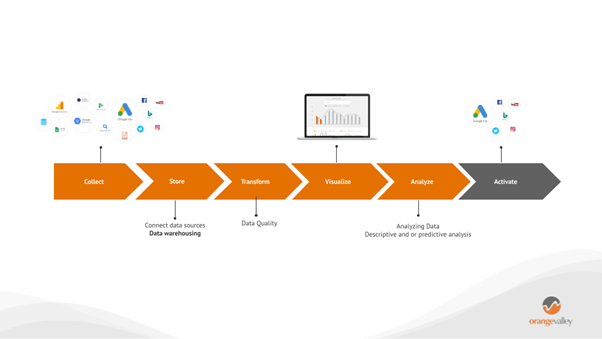Building and maintaining a strong self-serve analytics program is essential for top-performing companies. But not all businesses make it a priority. In conjunction with Women in Analytics, Amplitude hosted a three-part webinar series to tackle that issue and other challenges:
- Demystifying Data Governance dug deep into why governance matters and how to get started or step up your efforts.
- Unleashing Self-service Analytics shared the promise of making real-time data available to employees.
- The Impact of Cultivating a Data-Driven Culture wrapped everything up with advice on gaining buy-in at every level of your organization.
Throughout these three discussions, led by Women in Analytics member Kristy Wedel, Learning Experience Manager at AlignAI, the speakers shared plenty of tips for startups and enterprises alike. Whether you’re looking to take an established program to the next level or struggling to get the resources you need, read on for expert advice.
About the author: Michele Morales is a product marketing manager at Amplitude, sponsor of the 2024 DDMA Digital Analytics Summit.
Speed and agility are winning propositions
Analytics isn’t new, but the way companies gather and use data has completely changed in the last ten years. Digital analytics, especially self-service analytics, can be the difference between growth or a slow descent into irrelevance. As Sumathi Swaminathan, VP of Engineering at Amplitude, says, “Being able to quickly adapt to changing business conditions and market dynamics is critical for companies to win in their space.”
Traditional business intelligence tools often require decision-makers to formulate questions and wait for data to inform solutions. Now, there is no need to choose between speed and information.
“Broadly, I think businesses now understand that speed is the only way to grow revenue, diminish competition, and stay fresh in customers’ minds.”
– Sumathi Swaminathan, VP of Engineering, Amplitude
Self-serve analytics enable that agility—and not just at the leadership level. By understanding prospective and existing customer behavior, employees in departments ranging from marketing to product to operations are empowered to make quick, data-driven decisions. Self-serve analytics gives the answers directly to those with the big questions.
The best way to get started: Just do it
Many companies are intimidated by implementing a new self-serve analytics program, especially given the complexity of legacy business intelligence products.
“As you start making faster decisions . . . the value will become very obvious to the business.”
– Sumathi Swaminathan, VP of Engineering, Amplitude
Sumathi recommends a gradual transition plan that eases in new tools while enabling employees to continue using their old system. Offer training, set key performance indicators (KPIs), and launch pilot projects to show fast value.
Carolyn Feibleman, Principal Product Manager at Amplitude, adds that giving the change a positive spin can do wonders. Look to emulate your successful peers, using their data policies to inform yours. Competition can help motivate your employees to embrace your new system.
Analytics is an incremental process
It’s tempting to take advantage of everything a new platforms have to offer, but our panelists recommend launching an analytics program step-by-step.
Before working with data, champions can start by building data glossaries. Even if it’s not at a company-wide level, you can decide within your team what each product metric (user session, repeat visit, monthly active user, etc.) means. Share this glossary with your collaborators, and you’ve already started to build alignment on your company’s approach to data and analytics.
“Any of us who are really responsible for data and who care about where we’re going . . . anyone can start.”
– Carolyn Feibleman, Principal Product Manager, Amplitude
Then, start with key questions your team wants answered—two or three pieces of information that can lead to quick wins. Delivering value to your organization will make your team feel proud of their work and prove to leadership that further investment is worth it. Once you have that first win, ask what the next urgent question is and use it to guide your next project. Build momentum by offering a series of small achievements and, before you know it, you’ll have a robust analytics program.
Data governance matters as much as data access
Data wins don’t happen without careful curation of your data, which is why Carolyn advocates for a strong data governance program. Successful governance results in organized data, alignment on who is responsible for data, and strong oversight to ensure your data is well cared for.
It’s easy to make a business case for a data governance strategy, especially considering the compliance issues at stake. Ensuring you’re collecting, storing, and using data appropriately is essential to risk management.
Carolyn points out that executives often assume IT or other technical teams should own risk management because they see it as inherent to a system. But she cautions against that viewpoint. Data breaches come back to the highest levels of leadership. A smart CEO is plugged into their company’s security practices and stays personally aware of potential risks and threats.
“A lot of us don’t think about the cost of having too much or duplicative data.”
– Carolyn Feibleman, Principal Product Manager, Amplitude
There’s also the question of optimizing costs and utility when collecting and storing data. For example, data stored twice—or kept for too long—will cost more as it accumulates. And data that comes without metadata will be much less useful. A strong data governance program oversees these storage and labeling practices and multiples the return on investment (ROI) on your data collection efforts.
The three pillars of data governance
Morgan observes that a strong data governance framework has three parts: education, instrumentation, and maintenance.
- Education refers to understanding what data to collect and store, and whether it complies with company policies and industry regulations.
- Instrumentation refers to the consistency of data names and labels. Things like capitalization, use of underscores and dashes, and necessary metadata fall within this category. Standardizing your system at the start saves headaches in the future. Once you have a standardized taxonomy, you can start implementing it in your data tool.
- Ongoing maintenance keeps your data useful and your company in compliance. Accountability matters, whether this effort is owned by a single team or a cross-functional data council.
“[There is] technical debt, and [there is] data debt. . . . We have to fix it. We have to clean it. We have to get it ready and structured.”—Morgan Templar, CEO, First CDO Partners
Always start by defining your goals
Every data program or initiative Amplitude VP of Value Marchelle Varamini launches starts with a plan. A clear objective gives each stakeholder a mission and prevents projects from floundering in the depths of their data collection. What should that objective be? Marchelle always looks to the KPIs that departments track.
“In any conversation and in any decision you’re making, make sure you’re anchored on the business reasons for the work you’re doing, versus it being the work you’re doing to define business reasons later.”
– Marchelle Varamini, VP of Value, Amplitude
Marchelle likes to use value maps to start any discussion. She starts by asking what a business is trying to achieve—what it values. Next, she digs into any challenges that surround each value. That’s when she starts thinking about the metrics that can be used to solve them.
Effective data operations are collaborative, not isolated
Strong data operations include two types of collaboration: between employees in different roles on the same team and between different teams across the company. Combined data efforts are a sign of a strong data culture, so Marchelle likes to encourage cross-functional work.
One way to encourage effective collaboration across the company is by creating a team to coordinate collaborative efforts. Companies with mature data operations designate employees to think strategically about how the company will gather and use data, oversee governance, and bridge the gap between executives and employees when questions about data practices arise. Some have a centralized data team; others have a data council that calls in stakeholders from across the company. Either approach can work as long as the team understands the needs of every person who uses data.
For companies that don’t have teams dedicated to thinking about data, Marchelle likes to encourage employees to do this work. She asks questions to make them think about how others might use the same data they’re gathering. Every part of a company is interconnected, and most datasets have a secondary use elsewhere.
Building a data culture from the ground up
Most of us aren’t executives, so we can’t declare our companies will be data-driven and make it so. We have to lead from the bottom up.
As an employee and user of analytics tools, the best thing you can do is use data to tell the story of how you’re making a difference. Showing the impact of your work supports a larger data culture, which is why each of our panelists talked about building projects with milestones and celebrating small wins.
Of course, getting more resources for your grassroots program means winning executives over. Both Morgan and Carolyn agree the CFO can be a strong ally once you find a way to move the needle. Demonstrating a big ROI from a small initial investment will convince them these efforts are worth it.
You may face political challenges—sometimes, data will uncover failures that others won’t want to publicize. Other times, competing organizational priorities take the resources you were hoping for. These are hard to overcome, but on the flip side, data can identify weak spots and point to their solutions. Marchelle says she’s always found it easier to get help if she admits something is wrong. Additionally, data may help you see when two initiatives that seem at odds with each other are connected.
The only way to learn these truths is through experimentation, which takes us back to our second lesson: Sometimes, you have to become a champion and get things rolling.
Experimentation makes our work richer
As companies grow out of startup mode, they tend to lose the taste for curiosity. Some startups fail so fast, it becomes clear they were asking questions about a need that never existed. Data and analytics can help companies navigate both obstacles if they’re used thoughtfully.
Framing analytics as a scientific process, as Marchelle does, helps teams iterate toward growth. After all, if you don’t prove your hypothesis correct, the logical next step is to ask what other factors you might test. This mindset can also help failure-averse teams or corporations rekindle the habit of trying new things. There’s no such thing as a “failed” experiment. Even if yours didn’t turn out as expected, you’ll still learn from your data.
Over the past decade, we’ve seen the power of analytics firsthand as companies have used analytics platforms to navigate a shifting digital product landscape. If you set your company up with a strong data program now, you’ll be ready to keep up with the next decade’s changes.
Key takeaways
- Self-service analytics are powerful for companies that want to be agile, and the best way to get started is by empowering teams to dive in with pilot projects.
- Leading companies think about data governance early to reduce risk and ensure efficiency.
- Questions connected to business value are the best starting point for meaningful analytics work.
- Effective companies encourage collaboration so teams can understand each others’ data needs and work together to solve problems.
- A strong data culture comes from both the leadership and the team level, and you can champion a data-driven approach from either.

 Weiwei Liu-Schröder is Data & Measurement Lead at Google (Sponsor of the 2024 DDMA Digital Analytics Summit)
Weiwei Liu-Schröder is Data & Measurement Lead at Google (Sponsor of the 2024 DDMA Digital Analytics Summit)

